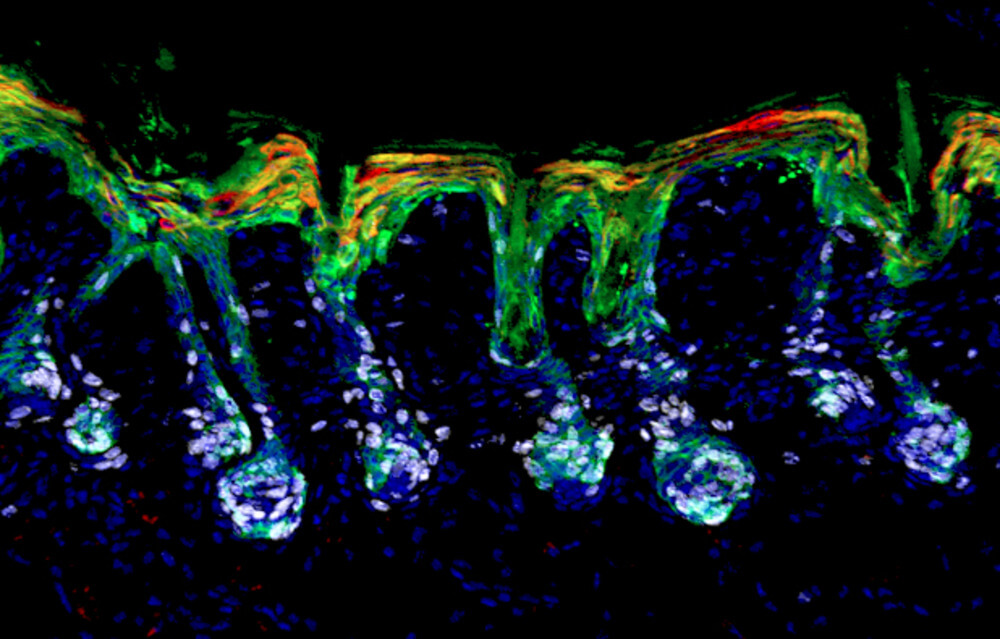NEW YORK — Is vitamin A the missing ingredient in explaining how wounds heal — and cancerous tumors grow?
When a child cuts their finger or scrapes their knee, skin stem cells charge to the rescue, generating new skin to heal the wound. However, not all stem cells that help with healing work on skin regeneration. Some cells, that originally promote hair growth, adapt to the fill urgent healing needs. These former hair follicle stem cells transform into epidermal stem cells, altering the local repair efforts. To help this transformation along, they first enter a flexible state, temporarily exhibiting characteristics of both hair and epidermal stem cells through the expression of specific transcription factors.
The bad news is research shows that once stem cells have entered this state, called lineage plasticity, they don’t work as effectively until they choose which direction they want to go. Now, researchers from Rockefeller University have found that retinoic acid, the biologically active form of vitamin A, could be key to addressing this.
“Our goal was to understand this state well enough to learn how to dial it up or down,” says Rockefeller’s Elaine Fuchs in a university release. “We now have a better understanding of skin and hair disorders, as well as a path toward preventing lineage plasticity from contributing to tumor growth.”
Lineage plasticity has been demonstrated to be a natural response to wound healing — and an unnatural trait of cancer. Minor skin injuries like scrapes are the best way to study this occurrence because the outer layers are subject to continuous wear and tear. Once the abrasions damage the epidermis, hair follicle stem cells come running to help.
Fuchs and the team wanted to further examine lineage plasticity because it, “can act as a double-edged sword,” explains Matthew Tierney, lead author on the paper and an NIH K99 “pathway to independence” postdoctoral awardee in the Fuchs lab.
“The process is necessary to redirect stem cells to parts of the tissue most in need but, if left unchecked, it can leave those same tissues vulnerable to chronic states of repair and even some types of cancer.”

To take a deeper look, Fuchs and her lab screened small molecules for their ability to resolve lineage plasticity in cultured mouse hair follicle stem cells, under conditions that simulated a wound state. To their surprise, vitamin A was crucial for the stem cells to exit lineage plasticity and essentially forced them to either be hair cells or epidermal cells.
“Through our studies, first in vitro and then in vivo, we discovered a previously unknown function for vitamin A, a molecule that has long been known to have potent but often puzzling effects on skin and many other organs,” says Fuchs.
The researchers found that genetic, dietary, and topical interventions that boosted or removed retinoic acid from mice all validated the role that this substance has in balancing stem cell response to hair growth and skin injury. Still, retinoids did not carry this out alone. They worked with signaling molecules like BMP and WNT, which impacted whether the stem cells should actually help stimulate hair regrowth or remain inactive.
Further, the research also showed that retinoic acid levels have to drop for hair follicle stem cells to assist in wound healing. If levels are elevated, they won’t enter lineage plasticity and therefore not be able to help. If they are too low, the stem cells might focus on wound healing too much and leave hair growth behind.
“This may be why vitamin A’s effects on tissue biology have been so elusive,” Fuchs says.

For a while, retinoid and vitamin A applications have yielded confusing results. Topical retinoids can promote hair growth in wounds, but excessive use has been linked to preventing hair cycling and causing alopecia. This study provides more insight into how retinoids can act as a balancing scale through their regulation of hair follicle and epidermal stem cells.
“By defining the minimal requirements needed to form mature hair cell types from stem cells outside the body, this work has the potential to transform the way we approach the study of hair biology,” explains Tierney.
The jury is still out on how retinoids impact other tissues.
“When you eat a carrot, vitamin A gets stored in the liver as retinol where it is sent to various tissues,” Fuchs says. “Many tissues that receive retinol and convert it to retinoic acid need wound repair and use lineage plasticity, so it will be interesting to see how broad the implications of our findings in skin will be.”
The lab is also interested in seeing how this information applies to lineage plasticity in cancer, specifically squamous and basal cell carcinoma.
“Cancer stem cells never make the right choice—they are always doing something off-beat,” Fuchs says. “As we were studying this state in many types of stem cells, we began to realize that, when lineage plasticity goes unchecked, it’s a key contributor to cancer.”
“It’s possible that suppressing lineage plasticity can improve prognoses,” Fuchs says. “This hasn’t been on the radar until now. It’s an exciting front to now investigate.”
The findings are published in the journal Science.
A Dietitian’s Take
For some time, vitamin A has been shown to support wound healing. Many hospitals across the nation include vitamin A as part of their nutrition protocol for patients with pressure injuries. It helps to support cell growth, immune function, and generate an inflammatory response that supports healing. It also aids in collagen synthesis, which is a crucial part skin regeneration.
It will be interesting to see how research continues to delve deeper into the mechanisms of stem cell biology and its relationship to retinoic acid. Although there is research on minor skin scars and abrasions, it would be beneficial to ultimately have literature on larger wounds like deep tissue injuries. These more severe wounds heavily affect older people who are more prone to skin breakdown and those who are bedbound due to a medical condition.
You might also be interested in:

So, like most everything else, Vitamin A is a deadly two edged sword.